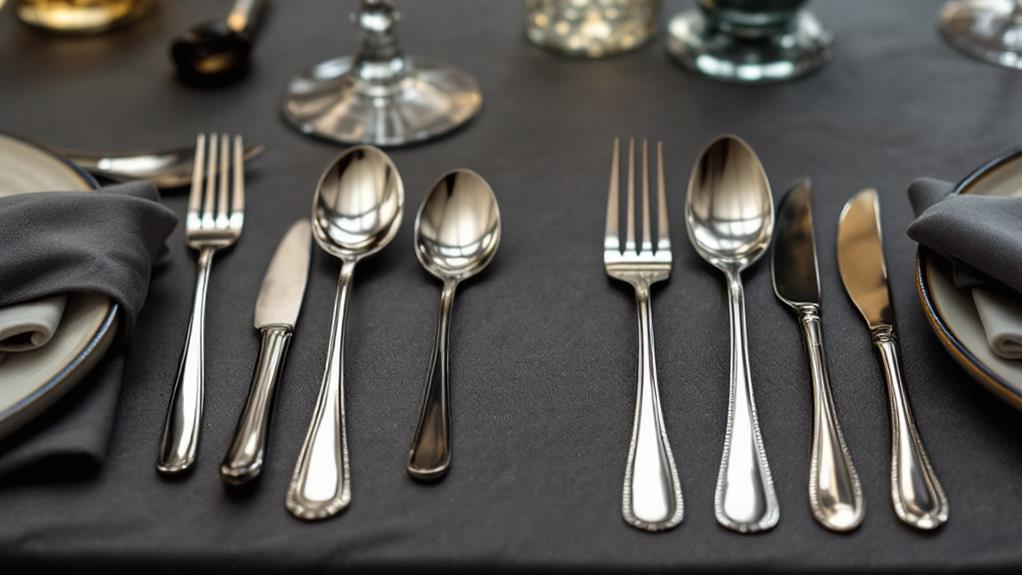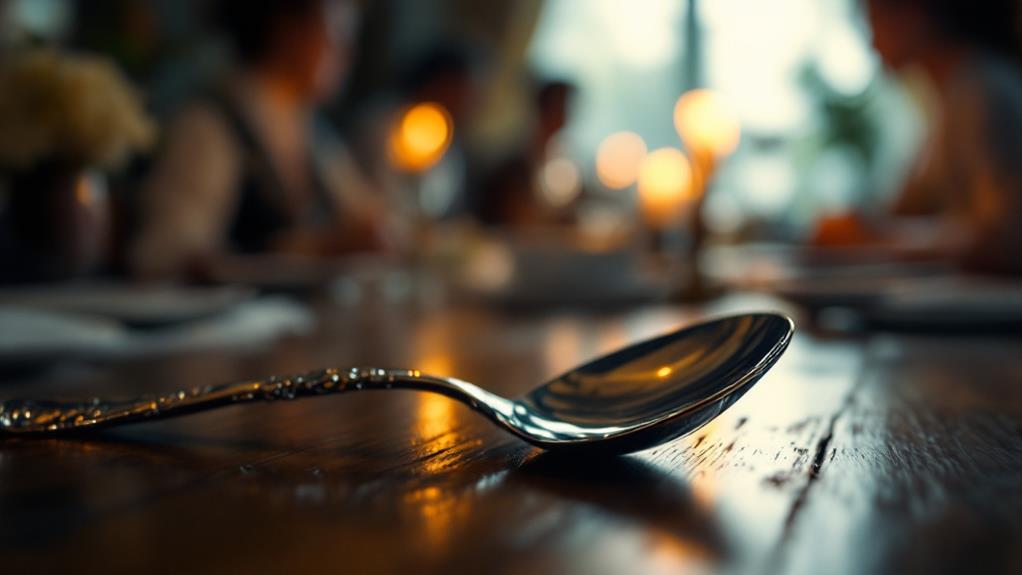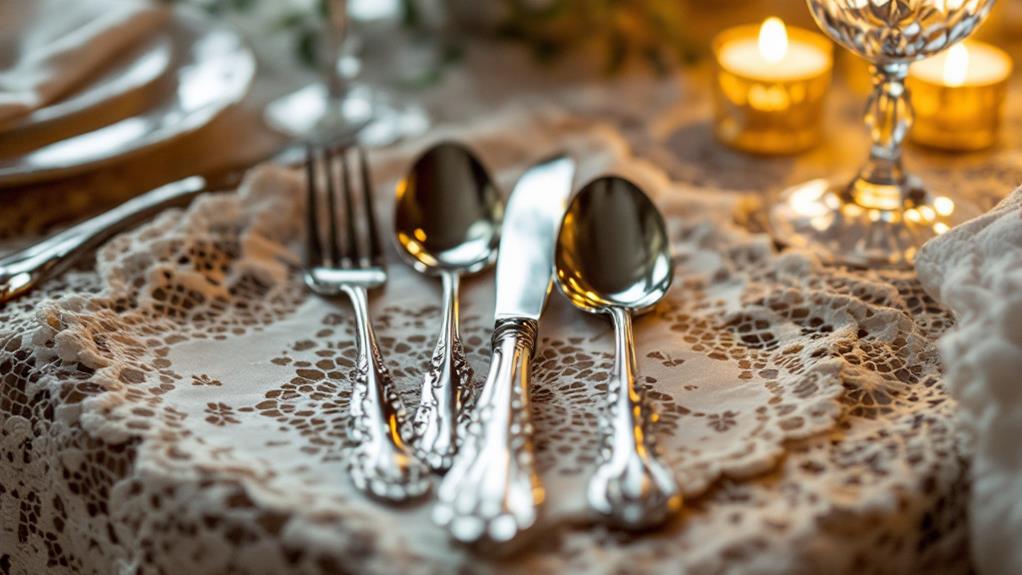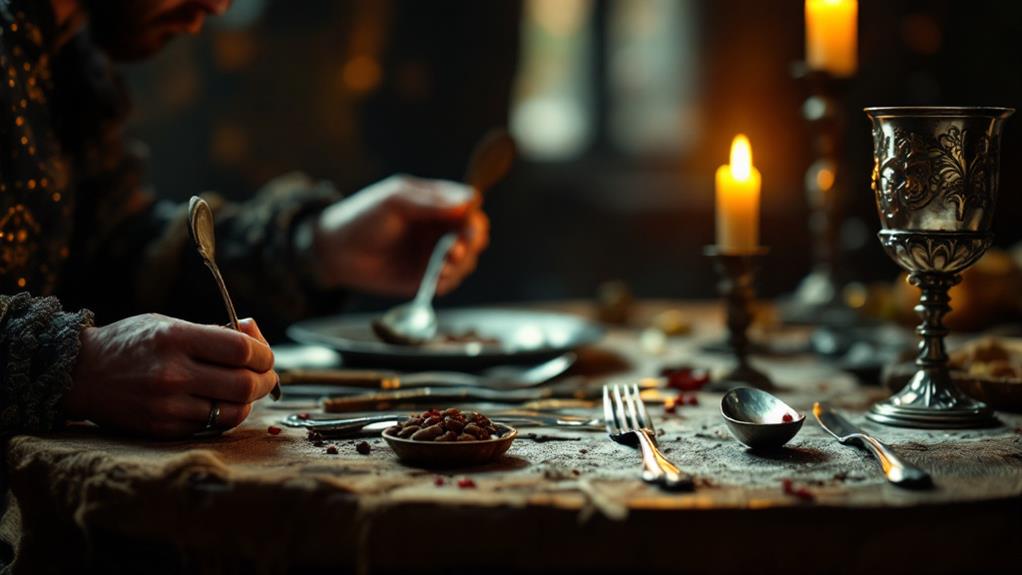History of Silver and Antique Silverware
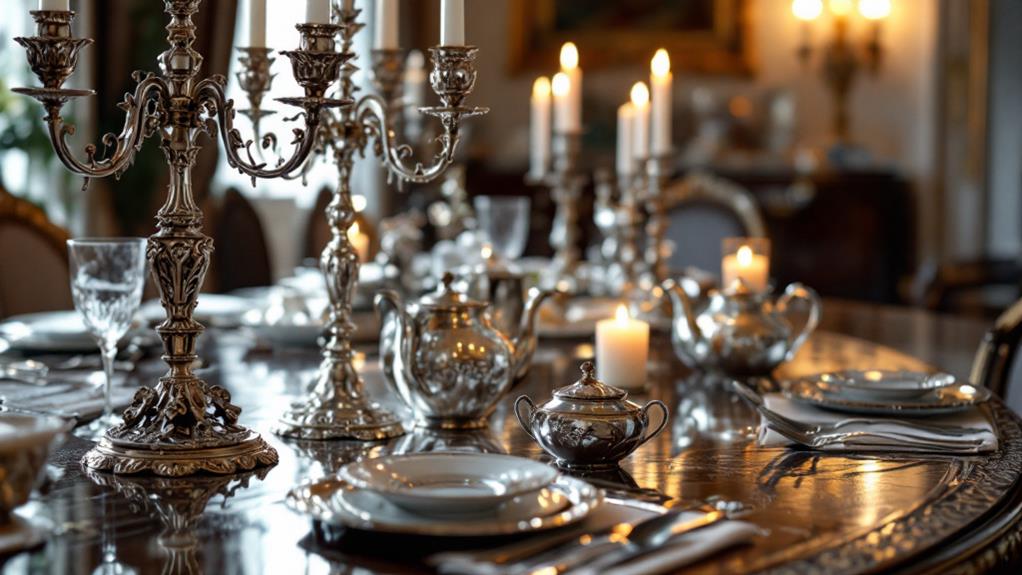
Silver's appeal has enchanted humanity for millennia. From ancient currency to modern technology, it's been prized for its beauty and versatility. You'll find silver's history woven through civilizations, from religious artifacts to luxurious tableware. The exploration of New World silver deposits reshaped global economies, while the Industrial Revolution brought new manufacturing techniques. Antique silverware, especially from the Georgian and Victorian eras, remains highly collectible today. Each piece tells a story of craftsmanship and social status. Silver's path from ancient treasures to modern marvels is a captivating tale of human ingenuity and artistic expression. There's much more to uncover about this precious metal's enduring legacy.
Properties of Silver
Silver boasts several exceptional properties that have made it a prized metal throughout history. When you look at silver, you'll immediately notice its distinctive shiny, white appearance. This lustrous metal catches the eye and has enthralled humans for centuries. But silver's appeal goes far beyond its aesthetics.
You'll find that silver is incredibly versatile due to its malleability and ductility. These properties allow it to be easily shaped into various forms, from delicate jewelry to intricate silverware. What's more, silver's resistance to corrosion and oxidation guarantees that your silver items maintain their beauty over time.
In practical applications, you'll appreciate silver's high electrical and thermal conductivity. This makes it priceless in electronics and industrial processes. Perhaps most surprisingly, silver possesses aseptic and antibacterial qualities, making it useful in medical applications and assuring your silverware remains hygienic.
As you investigate antique silverware, you'll uncover how these properties have been harnessed throughout history. The metal's durability, combined with its malleability, has allowed artisans to create intricate designs that have stood the test of time, preserving silver's legacy as a symbol of luxury and refinement.
Ancient Silver Uses
Throughout the annals of ancient history, you'll find silver playing a fundamental role in various societies. As early as the 7th century BC, silver was used as currency in the ancient Near East. You'd have encountered staters, drachmas, and obols made from this precious metal, signifying its importance in trade and commerce.
Ancient civilizations often associated silver with wealth, value, and affluence. Skilled craftsmen used it to create luxury goods, including exquisite jewelry and small devotional objects. These pieces weren't just for the living; they held significance in death as well. You'd frequently uncover silver items placed in high-status graves, highlighting their symbolic meaning and importance to the deceased.
The ancient world also saw silver used in religious contexts. People made offerings to the gods using silver, believing it would safeguard passage to the afterlife. This practice emphasizes the metal's spiritual significance alongside its material value. It wasn't until the 15th century, following European colonization of the Americas, that silver's abundance led to expanded production and use across Europe, revolutionizing its accessibility and applications.
Medieval Silver Craftsmanship
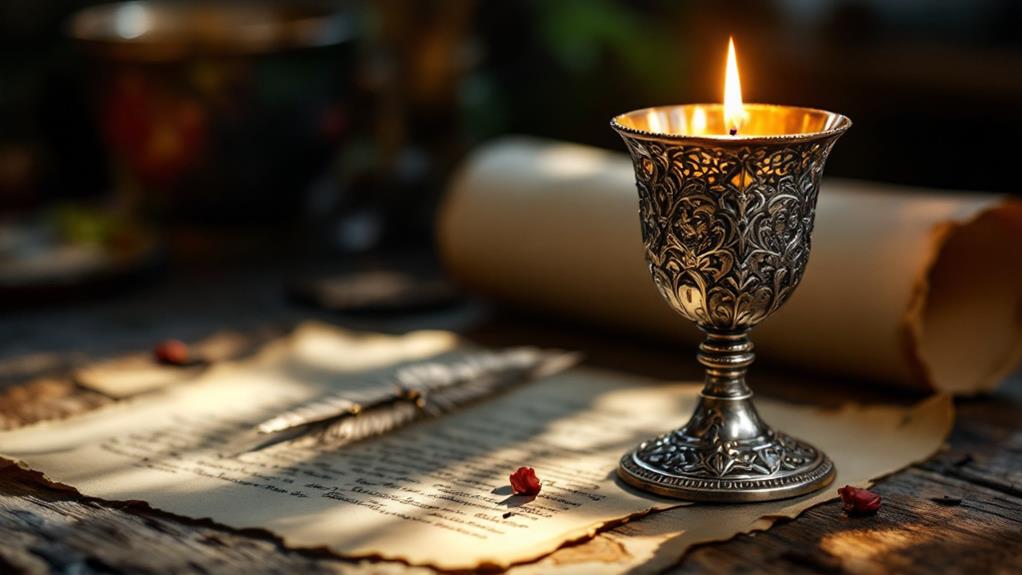
How did silver craftsmanship evolve during the medieval period? You'll find that silver took on new significance, especially in religious contexts. The Church used silver extensively for sacred objects like reliquaries and chalices, symbolizing its power and prestige. This demand spurred advancements in silversmithing techniques.
The introduction of Sterling silver alloys marked a turning point in medieval craftsmanship. Unlike modern stainless steel, which contains different materials, Sterling silver provided durability while maintaining the metal's luster. This allowed silversmiths to create more intricate designs and elaborate pieces.
You'd see the rise of silversmithing guilds across Europe, nurturing innovations in techniques such as chasing, repoussé, and engraving. These skills were applied to both religious and secular items, with wealthy nobility commissioning grand silver furnishings and tableware to showcase their status.
Silver's prestige extended beyond personal use. It became integral in creating ceremonial and civic objects, like presentation cups and trophies. The medieval period truly enhanced silver craftsmanship, elevating it from mere utility to an art form that reflected power, wealth, and achievement.
Renaissance Silver Innovations
During the Renaissance, you'd witness an extraordinary change in silver craftsmanship. European silversmiths developed advanced techniques like casting, repoussé, and chasing, revolutionizing the production of silver items. These innovations allowed artisans to create intricate decorative objects that became symbols of wealth and power.
As nobility and the Church commissioned elaborate silver pieces to showcase their status, you'd see a surge in demand for high-quality silverware. The discovery of silver deposits in the Americas in the 16th century fueled this growth, providing an abundance of raw material for European silversmiths.
If you attended a Renaissance-era dinner party, you'd encounter elaborate silver tableware and ornate decorative objects. The rise of formal dining rituals among the elite drove the need for sophisticated silver services. Renowned artisans like Benvenuto Cellini in Italy and Pierre Mangot in France pioneered innovative designs that blended classical forms with Renaissance ornamentation.
These expert silversmiths made silver pieces that were not just functional but true works of art. Their creations set new standards for craftsmanship and aesthetics, influencing silver design for generations to come.
New World Silver Discovery

The Renaissance's silver boom paled in comparison to what came next. In the 16th century, you'd witness a seismic shift in the History of Silver as Spanish conquistadors found vast deposits in the New World. Peru, Bolivia, and Mexico became silver powerhouses, flooding Europe with unprecedented amounts of the precious metal.
This influx of New World silver reshaped the global economy and fueled Spain's rise to power. You'd see silver coins circulating more widely, even reaching the growing middle class. The abundance led to a golden age of silversmithing, with artisans crafting increasingly elaborate tableware and luxury goods.
The impact of this discovery extended far beyond Europe. In what would become the United States, silver played a fundamental role in shaping colonial economies. Meanwhile, in South America, the name "Argentina" itself stems from the Latin word for silver, highlighting the metal's importance in the region.
As you investigate antique silverware, you'll notice the intricate designs and craftsmanship that emerged during this period, a direct result of the New World silver boom.
Golden Age of Silversmithing
Fueled by the New World silver boom, the 16th to 18th centuries ushered in a golden age of silversmithing. You'd find European expert craftsmen like Paul de Lamerie and Paul Storr creating opulent pieces for the nobility and elite. Their works, often in Rococo or Neoclassical styles, reflected the rising wealth and status of their patrons.
Across the Atlantic, American silversmiths like Paul Revere shifted from Rococo to Neoclassical designs after the Revolutionary War. They crafted silver presentation vessels to commemorate civic and political victories, including pieces for King George.
Silver's association with luxury and status was particularly evident in French dining culture. The proliferation of silver tableware used to create an atmosphere of refinement included:
- Ornate centerpieces
- Elaborate serving dishes
- Intricately designed flatware
The French word "orfèvre," meaning goldsmith and silversmith, highlights the prestige of the craft. Even in sports, silver's allure prevailed. The 17th-century Kyp Cup inspired modern prestigious trophies like the Stanley Cup. This golden age set the stage for silver's enduring legacy in fine dining, commemorative pieces, and sporting achievements.
Industrial Revolution Impact
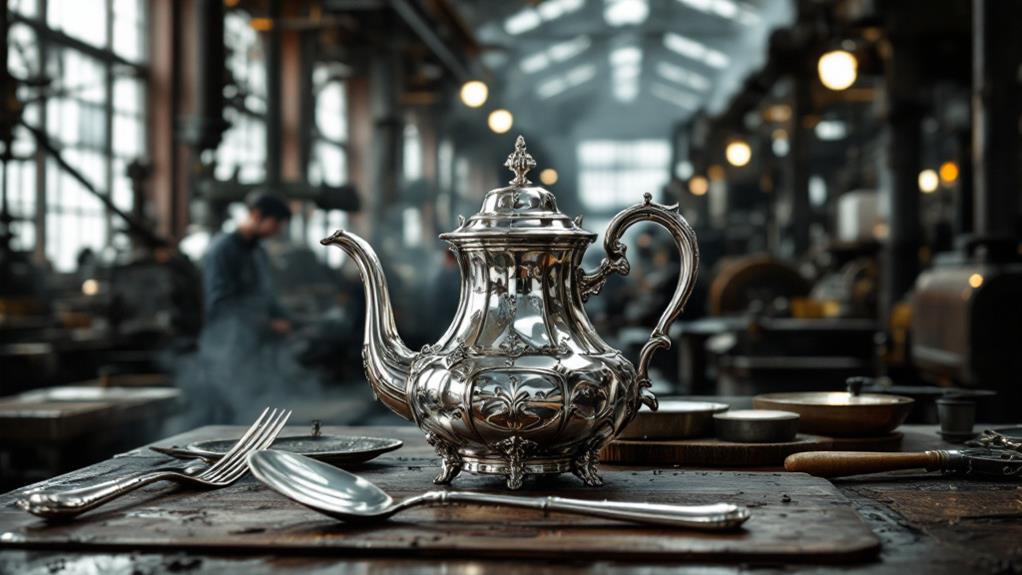
As the gears of industry began to turn, the Industrial Revolution dramatically altered silver production and consumption. You'd find that mechanization and mass production techniques used to make silverware made these once-exclusive items more accessible to the growing middle class. The Industrial Revolution brought about new types of manufacturing processes, like silver-plating and the development of stainless steel, allowing for more affordable and durable alternatives to solid silver.
The unearthing of large silver deposits, such as the Comstock Lode in 1859, increased the supply and reduced the cost of silver. This expansion in availability led to a surge in silver's use across various applications. Dining and entertaining became increasingly theatrical, with specialized silverware and elaborate rituals reflecting the status and wealth of the middle and upper classes. Pieces often served as symbols of luxury and exclusivity.
Companies like Tiffany & Co. rose to prominence during this period, creating iconic silverware patterns that captured the essence of the era. Their designs, such as Chrysanthemum and Olympian, became highly sought-after status symbols, representing the pinnacle of craftsmanship and elegance in the new industrial age.
Modern Silver Applications
While the Industrial Revolution altered silver's role in everyday life, today's technological advancements have expanded its applications far beyond the dining room. You'll find silver in various modern technologies, from electronics to solar cells and superconductors. Its unique properties, like high electrical and thermal conductivity, make it essential for industrial and medical equipment.
Remember those antique silver pieces from the George III era? Today's silver has taken on a whole new purpose. It's used in water purification and disinfection, thanks to its antibacterial properties. This helps prevent the spread of diseases, making silver a fundamental element in public health.
The photosensitive nature of silver compounds continues to be employed in:
- Photography and X-ray imaging
- Solar panel production
- Advanced electronic circuits
You might have used silver without even realizing it. Silver catalysts play a pivotal role in the chemical industry, aiding in the production of various organic compounds and pharmaceuticals. While antique silver still holds its charm, modern applications have revolutionized this precious metal into an indispensable component of our technological world, far removed from its historical use in flatware and decorative pieces.
Collecting Antique Silverware
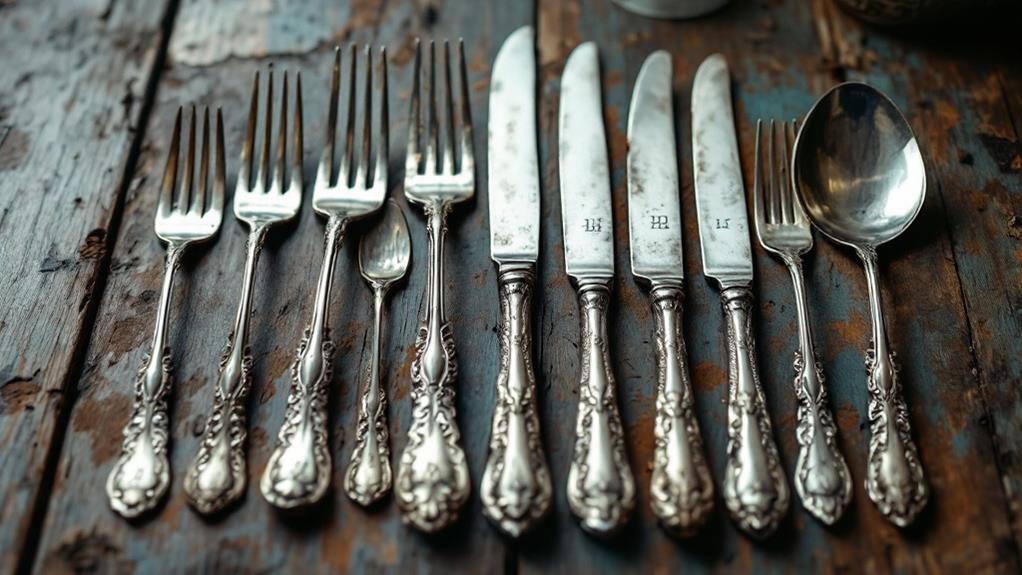
Collectors and enthusiasts have rekindled interest in antique silverware, turning these historical pieces into prized possessions. As you immerse yourself in this fascinating hobby, you'll uncover that silver utensils first appeared in ancient civilizations, but it wasn't until the 16th Century that they became more common among the wealthy.
The 18th Century saw a surge in silverware production, with craftsmen developing intricate designs and patterns. During this period, silverware was often made by hand, resulting in unique pieces that are highly sought after today. You'll find that many collectors focus on specific eras, such as Georgian or Victorian, each with its distinct style and charm.
When collecting antique silverware, you'll want to pay attention to hallmarks, which can help you identify the piece's origin, maker, and date. The late 18th Century marked the introduction of standardized hallmarking systems in many countries, making it easier for modern collectors to authenticate their finds. As you build your collection, you'll develop an eye for quality craftsmanship and learn to appreciate the historical significance of each piece.

